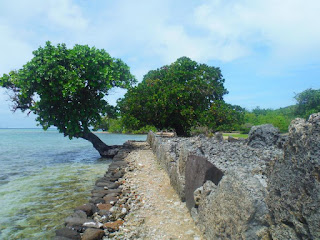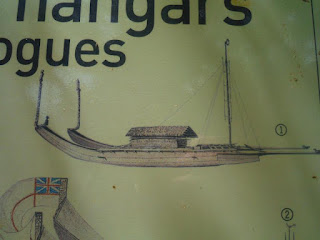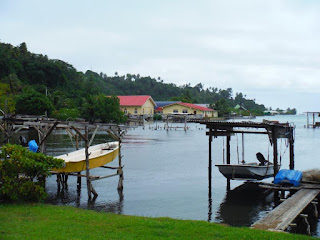From
the time we cleared the pass on Huahine, by the village of Fare, it
took us about 4 hours to sail the 18 miles over to Raiatea. It was
trading off sun and rain as several clouds passed over us. We had
Pass Teavamoa (the Sacred Pass) in our sights, when a downpour came
and the island disappeared in front of us. So we took down all sails
and motored slowly, waiting for the rain to pass. Once it did, we
had sun again and could see the channel markers we needed to go
between. But behind us was another cloud so we pushed the motor a
bit and made it in while the sun was still shining. There was a
small hut on our starboard side and a guy in a boat fishing nearby.
Looked like he caught a fish as we passed him.
We
came in the sacred pass because we wanted to see the “father of all
Maraes” Marae Taputapuatea. This was the largest Anthropological
sight in all of the Society islands and the opening in the pass
headed directly at it. We looked around for a place to anchor, but
it was 100 feet plus everywhere. We saw a few boats nearby, but
realized they were on moorings and none were open. So we followed
around the shallow water until we found a 70 foot spot in Baie
Faareparahi (that is a mouth full!!) with a mud bottom and is
protected from those squalls coming in from the South East. As we
were backing up to secure the anchor in the mud, we realized there
was a coral shelf all around us at about 3 feet deep. The water
depth goes from 70 feet to strait up to 3 feet!! We decided to
re-anchor a bit farther away from the coral shelf! By this time it
was raining again, so we stayed below and I baked a cake.
The
next day was sunny again, so we found a place to lock the dingy close
to the road and we started walking back toward the Marae. It was a
Sunday and we saw only 3 cars, all going the other direction.
Suddenly a “Le Truck” appeared and stopped to pick us up.
Everyone was dressed in their Sunday finest. We smiled at them all
and said “Iorana” which means hello in Tahitian. We stopped in
front of a church, where I expected them to get out, but we picked up
an elderly lady and no one got off. Must all go to a different
church?! She spoke a bit of English and asked where we were going.
She got the driver to stop and let us off at the proper spot. When
we tried to pay him for our ride, he would not accept any money.
“Mauruuru” we said, which means thank you in Tahitian. As they
drove off, 3 young girls in the back said in perfect English “good
bye!”. We smiled and waved. The people here are SO nice!
We
explored the Marae while we waited for our friends Eric and Leslie
from the boat Kandoo to
join us and pick up some mail we brought them from Tahiti. The guide
book says this was the most important Marae in all of French
Polynesia. The big blocks of coral were taken from the reef at low
tide by lighting fire to them to make them crack. The stones were
quite large, as is the whole site very impressive. Back in the day,
Captain Cook visited here and the information signs show some of the
drawings from his naturalist that showed what the scene looked like
when they were here. The Lonely Planet guide book (thanks Katie!)
describes the big vertical stone in the middle of the courtyard as
the “stone of mana”. Mana is a person's power or energy. The
Mata Rahi was known as the “great eye” stone.
This
was all very interesting, but when Eric and Leslie arrived we got a
different story! Eric had sailed to Raiatea as a boy with his Aunt
and Uncle and had even spent 2 years in high school here back in
1970's. Now they have decided to stay here and put their two boys in
school here, walking in their father's foot steps. Eric told us the
stories he had been told by the local “Sorcerer” who had given
him his first tour of the place back then. This was the headquarters
for the believers in “Oro” the God of War. Back then Sorcerers
had to sacrifice a human life to keep their power or mana. This had
to be done once a year before the anniversary date of their becoming
a Sorcerer. He said the one big black vertical stone had been
misplaced when the site was rebuilt. (The missionaries had all of
these sites destroyed in the early 1800s, but with a rejuvenation for
their history, the locals rebuilt them in the late 1900s.) The big
stone used to lay horizontal so the flat side was up and the sharp
edge at the top was used to cut heads off! They were left their to
drain their blood into the courtyard as the Sorcerer somehow absorbed
their mana.
Now
to find the person who was going to be sacrificed was another great
story. Normally they chose a person who was generally annoying or a
trouble maker for political reasons. If they could not find anyone
on Raiatea, the took their canoes over to Huahine to find someone.
The code was “do you have any broken gourds?”. This meant, “do
you have anybody who is worthless we can take home to kill?” Now
you did not want to kill a person who was old or sickly, they had
already lost much of their mana, so it had to be a younger or
stronger person. Eric showed us the “grater” stone too. If a
person was pale or green from the ride back in the bottom of a canoe
from Huahine, they would use this stone to make their skin red and
rosy, so it looked like they had more mana, before they chopped off
their head for Oro.
Once
the body was done bleeding out, they were buried inside the tall
stones at the head of the courtyard and covered them with the small
rocks. How many maraes have we been to and did not know why there
are always tall rocks in a square at one end?! Eric said you knew
there really were bodies buried in there because sometimes you could
find teeth outside of a crab hole near the marae in the crab's
discarded dirt from his hole. He said he had found a tooth here as
late as 1994! Who knows if any or all of this is true or fiction,
but it does make for a good story!
Over
by the big rock Mata Rahi at the other courtyard, Eric explained that
the use for this big rock was to protect the chiefs. All chiefs wore
big protective belts and shields over their chests, but when they
entered the sacred Marae they had to remove it to show respect to Oro
and his deities. So as not to be killed by an arrow or spear, they
hid behind the rock while they were praying or listening to the
Sorcerer speak. Eric really made this place way more interesting than
the tour book!! Right now the locals are trying to make this a World
Heritage site to protect it from ever being destroyed again. I guess
what amazes me the most, is how fearful and murderous these people
were 200 years ago and now they are the sweetest people you have ever
met! At least there was one good thing that came out of those
missionaries!!
Later
that night, back on the boat, I saw one of the most beautiful things
ever. It started raining again, so I went out to moved the cushions
to a dry spot and noticed the water was lit up like a Christmas tree.
There is so much phosphorescence in the water that as each drop of
rain hit the bay, it glowed green! Down deeper you could see every
fish swimming as he made a bright glow deeper in the water when he
moved. It was mesmerizing and beautiful!!
The
next day we headed North inside the reef towards the neighboring
island of Tahaa. Both Raiatea and Tahaa are surrounded by one big
reef system. As we went past another pass through the reef, a Proa
paddler was resting near a green marker, but when he saw us he took
off to surf in our wake. It is kind of like drafting the car ahead
of you. He was quite studly and kept up with our 6 knots of boat
speed for an hour! It was hot, so Mike used our hand shower sprayer
to cool him off. When we got the camera out to take his photo, he
showed off by popping a wheelie, which is tipping his outrigger up
out of the water. As we followed the channel markers to cross over
to Tahaa, he waved bye and said thank you, as he paddled back to the
top end of Raiatea.
We
zigged and zagged thru the reefs inside the channel markers to the
West side of Tahaa. We anchored near Motu Tautau, which we had been
told has great snorkeling. This motu has a big resort on it, but
there is a small pass between two motus that they call the Coral
Garden. My friend had said it was so shallow that if you had big
boobs you had to breath in so you did not drag them on the coral!
Yikes! The next morning we donned our suits and snorkeling gear and
dingied over. They have a line of floats to mark it, so we anchored
just outside the floats closer to the smaller motu. There were big
coral heads everywhere, but there also was a channel thru them that
was a bit deeper. Here the fish swam right up to us, totally
unafraid. We realized they obviously feed the fish here and they
wanted to know if we brought anything with us. Oops, we did not
know. We were swimming along slowly when suddenly I saw the biggest
Moray Eel I have ever seen in my life. He was at least a foot tall
and over 6 inches wide. He came out of his hole completely swimming
after me. I was SCARED!! He was at least 6 feet long too, when I
got to see his whole body. I grabbed Mike's fin in front of me and
pointed rapidly. “Holy Crap!” I could hear him say thru his
snorkel. We swam away rapidly. Then we came upon a group of tourist
with some new fangled snorkel gear. I had never seen these type of
face masks before that cover your whole face and have a snorkel at
the top, making them look a bit like aliens. I guess it is only good
for shallow swimming, as if you wanted to dive down to look at
something deeper, there is no way to hold your nose to equalize your
ears. Then I realized that these tourist had a crazy French guide
with them and he was feeding another big Moray eel, then petting it
while it ate! None of the tourists did this, but we all watched the
crazy Frenchman. That was when I realized the guy chasing me was
just looking for food too. But at the time I thought he was thinking
I was gonna be his food!! We followed the tourists and headed back
to the dingy and boat. The only bummer about this whole episode is I
forgot to take my camera!!
We
were anchored next to one of those cool house boats, like the one
Coco the boobie bird lived on over in Huahine, so I took a photo of
it. Never did see anybody on board, but it sure would make a great
living platform out at the Magote in La Paz!! That night was clear
as a bell and we sat out on the deck staring at the zillions of stars
in the Southern Sky. We are working on learning the new
constellations we can see down here.
The
next day we woke up to fog and rain! We could not believe it! Not
the best conditions for snorkeling, so we motored over to the village
of Tapuamu on the main part of Tahaa. The water again was too deep
to anchor, so we picked up one of the moorings. When the rain
finally cleared, we decided to go ashore and check it out. All the
houses had so many pretty flowers in their yards. I love the way
people use bushes and shrubs to separate their property instead of
fences and walls. We had heard that this town has a local rum
distillery and we finally found it. After a short tour of the place,
we bought some rum at a pretty high price, but it was 50% alcohol.
No need to use much of it! I love their label with the double hulled
sailing canoe and the stars they navigate with.
We
could see Bora Bora in the distance and were ready to find our Bali
Hai as soon as the weather cleared. We sailed there the next day.
Pass Teavamoa at Raiatea
Here we leave red markers to the Left when entering, note the fish traps
hut to starboard entering the pas
fisherman with fish on
Baie Faareparahi
entrance to Marae Taputapuatea
wandering through the overgrown courtyards
interesting plants
Mike and the Banyan tree
wandering through the grounds
the beach area
note the circles on the rock on the right
the end of this marae drops right into the water
The courtyard of the Rock of Mana
Eric demonstrates on his wife Leslie how they chopped of heads
The sacrifice rock
one of the description signs showing what it may have looked like
Captain Cook being shown how they don't just eat white people
The altar at the rock of Mana
close up of wood carving looks like King Neptune to me
some of the offerings at the altar
statuette at altar
many small shells buried in a coral stone at the altar
the back side of the marae
Mata Rahi Marae
drawing from Capt. Cook's naturalist of what it looked like when they were there.
Note his ship in the background
offering my respect before entering where many people had died
Thinking this was the rock of Mana, I tried to feel its power
Pass Teavamoa looking out from the Marae
Mata Rahi
round coral rocks at the head of the Mata Rahi
The "grater" rock where they made rosy faces
Tree growing out over the lagoon
smaller Marae right on the water
what the big sea going double hulled canoes looked like
looking out at a motu on the reef
small plants growing strait out of a moss covered rock
Possibly fisherman Paulo's burial site
His headstone at the front
fish rock inside burial site
Mike on the other side, do you see the fish rock?
being tailed by a Va'a paddler
popping a wheelie in his canoe
the big mountains of Raiatea
a marina on the NE side of Raiatea where our paddler left us
boats anchored between the two islands
stay between the channel markers!!!
the fancy resort on Motu Tautau
a modern day double hulled boat house, I want one to take home to La Paz!!
What they used to look like
Mike admiring someone's yard in the village of Tapuamu in Tahaa
brilliant red flowers
flower hedges for privacy
fruit stand on side of the road with Pomplamoosse for sale
More privacy plants
red flowers on the side of the road, note the water drops from all the rain!
Tiare flowers, the official flower of French Polynesia
Fuchsia colored orchid
purple house
Land Rover defender a little dilapidated like the house it is parked by
crab is cleaning trash from his front porch
many fishing boats and their boat houses
Avatar on a mooring in the distance, nice dock!
muddy river water flowing down from the mountains
looking back at the village
locally made Tahitian Rum!! Love that label
sunset after a rainy day
The sky is on fire!
Bora Bora in the distance and Motu Tautau in the foreground and some charter boat
the reef on Tahaa as we are heading for the pass to go to Bora Bora
Satellite photo of Raiatea, Tahaa and Bora Bora







































































Hi Shelley and Mike,
ReplyDeleteLove the post as always, quite a fright with the mora swimming after you. We too are looking into buying these new type of snorkling masks, Christmas is coming and they would make a nice present. They are invented by the French, crazy Frogs, and are called Tribord or Easy Breath.